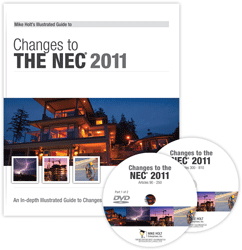|
2011 Changes to the NEC – 110.14
The following is an instructional page from our 2011 Changes to the NEC Textbook/DVD Package complete with graphics and video where applicable. As part of our on-going effort to provide free resources to help the industry, we will be sending this content as part of a series of newsletters. Each newsletter will feature pages taken directly from our textbooks. This can be a great training resource for your organization!
There are some important features in this text which help to highlight the changes that you should be aware of:
- Each Code section which contains a change includes a summary of the change, followed by a paraphrase of the NEC text affected by the change. Any specific change is denoted by underlined text and in the corresponding chapter color
- Graphics with green borders and 2011 CC icons next to the heading are graphics that contain a 2011 change; graphics without a green border or icon are graphics that support the concept being discussed, but nothing in the graphic was affected by a 2011 Code change.
2011 Changes to the NEC Part 1 |
110.14 Electrical Connections
Provisions for finely stranded conductors have been added.
110.14 Conductor Termination and Splicing. Conductor terminal and splicing devices must be identified for the conductor material and they must be properly installed and used.
Figure 110-10 (Click on image to enlarge)
Caution: When the insulation is stripped from an aluminum conductor and the conductor is exposed to air, an insulating film (aluminum oxide) immedi-ately forms on the conductor. This film can create a poor connection and overheating at terminations. Unless the terminal or the device is manufac-tured with the right contacts designed to break through the film and ensure a good connection, overheating may occur. An oxide inhibiting paste can be applied to aluminum conductors at terminations to help improve the connection, but this isn’t required.
Connectors and terminals for conductors more finely stranded than Class B and Class C, as shown in Table 10 of Chapter 9, must be identified for the conductor class.
Figure 110-11 (Click on image to enlarge)
Author’s Comments: According to UL Standard 486 A-B, a terminal/lug/connector must be listed and marked for use with conductors stranded in other than Class B. With no marking or factory literature/instructions to the contrary, terminals may only be used with Class B stranded conductors.
- Class B stranding (Standard) has 7 strands of wire per conductor in sizes 18-2 AWG, 19 strands in sizes 1-4/0 AWG, and 37 strands in sizes 250-500 kcmil.
- Class C stranding has 19 strands of wire per conductor in sizes 18-2 AWG, 37 strands in sizes 1-4/0 AWG, and 61 strands in sizes 250-500 kcmil.
- Class D stranding has 37 strands of wire per conductor in sizes 18-2 AWG, 61 strands in sizes 1-4/0 AWG, and 91 strands in sizes 250-500 kcmil.
ANALYSIS: Fine-stranded cables and conductors are a fairly new option in the NEC (2008 Article 690). The use of these cables has increased, but awareness of the special termination provisions for them has not. Now that installers are using these cables in more and more applications, the Code has recognized the need to alert NEC users to specific terminations that are required for these fine stranded conductors and cables.
The termination of finely stranded conductors is of the utmost importance when using them. Due to this, a new Table (Table 10 in Chapter 9) was added to the Code. The new language in this section refers to that table, making its provisions enforceable by the AHJ. |
2011 NEC Changes DVD Package |
 |
Don't let the scale of the code changes intimidate you, this package will get you up to speed on the most essential 2011 NEC changes quickly. The book is well-organized, easy to follow, and the full-color illustrations bring the material to life. The DVDs bring together a group of experts from the field to discuss the changes and how they apply in the real-world.
This program includes the following items:
- Changes to the NEC 2011 Textbook
- Changes to the NEC 2011 DVD 1 & 2 includes Articles 90 - 810
Product Code: 11CCDVD
Price: $198.00
 |
|

